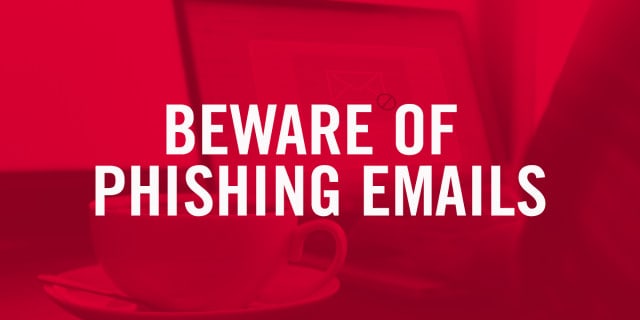
Check the Sender Address
Hover over the from address to see if the email is who it says it is. A quick Google search will often provide you with what the legitimate email address should be.
Look for Grammatical Errors
Legitimate companies are less likely to have grammatical errors as opposed to someone posing as a legitimate company.
Check the Salutation
If you receive an email with a generic salutation such as “hello sir/madam,” or “hi dear,” it is likely to be a scam. Reputable companies will have your name on file and are unlikely to address you in this manner.
Watch for Urgency
If an email is flagged or the subject line includes words like “urgent, time-sensitive, immediate action required,” it is likely not a legitimate email.
Question the Need for Credentials or Personal Information
Rarely will a legitimate company or agency request personal information through an automated email. SRT will never ask you for sensitive information over email, so if you receive an email request supposedly from SRT to provide personal credentials, it is best to call our direct company phone number and confirm the request.
Don’t Click on Suspicious Documents or Links
If there are documents or links within a questionable and unexpected email, it is most likely a scam. When in doubt, it’s best not to click on any links or download documents until you have confirmed the legitimacy of an email.
Think Critically
Some bad actors are trying so hard to fool unsuspecting people that they don’t think to ensure you utilize the service or company they are pretending to be. For example, you receive an email from someone claiming to be from Netflix, you panic, and open the link. However, you didn’t stop to remember that you don’t have a Netflix account. Something as simple as knowing you do not use the service can save you from opening a bad link.
However, if you do have an account with the company that you received an email from, like SRT, it is always best to call the number on their official website and verify. We are always happy to clear up any misconceptions and set your mind at ease. Keeping your personal information secure is our top priority!
 Can’t remember the balance on one of your gift cards? Make sure you don’t accidentally go to a fake gift card balance-checking site!
Can’t remember the balance on one of your gift cards? Make sure you don’t accidentally go to a fake gift card balance-checking site!
 People accidentally text the wrong number all the time, and you’ve no doubt received texts that were meant for someone else. Unfortunately, wrong-number texts aren’t always innocent mistakes. Scammers send “accidental” texts to catch you off guard and exploit your friendliness and kindness for financial gain.
People accidentally text the wrong number all the time, and you’ve no doubt received texts that were meant for someone else. Unfortunately, wrong-number texts aren’t always innocent mistakes. Scammers send “accidental” texts to catch you off guard and exploit your friendliness and kindness for financial gain.
 The AARP Fraud Watch Network Helpline has recently seen a rise in reports of PayPal scams. Cybercriminals use the payment system’s invoicing tool to send victims fake invoices for large purchases. When the invoices are sent, PayPal sends an official notification email to the recipient, which makes the otherwise fake invoices appear legitimate. The scammers include an official-looking message in the “seller note to customer” section of the fake invoice, encouraging the victim to call a fake customer service line to prevent the charges from being processed.
The AARP Fraud Watch Network Helpline has recently seen a rise in reports of PayPal scams. Cybercriminals use the payment system’s invoicing tool to send victims fake invoices for large purchases. When the invoices are sent, PayPal sends an official notification email to the recipient, which makes the otherwise fake invoices appear legitimate. The scammers include an official-looking message in the “seller note to customer” section of the fake invoice, encouraging the victim to call a fake customer service line to prevent the charges from being processed.
 According to the FTC, people are losing big money to criminals running complicated scams. Here’s how it works: A scammer pretending to be from a company you know contacts you, saying they supposedly spotted fraud on one of your accounts and your money isn’t safe. They connect you with someone else to supposedly help you move your money to “protect” it. The “helper,” who often claims to work for the government, is really a scammer trying to steal your money.
According to the FTC, people are losing big money to criminals running complicated scams. Here’s how it works: A scammer pretending to be from a company you know contacts you, saying they supposedly spotted fraud on one of your accounts and your money isn’t safe. They connect you with someone else to supposedly help you move your money to “protect” it. The “helper,” who often claims to work for the government, is really a scammer trying to steal your money.


